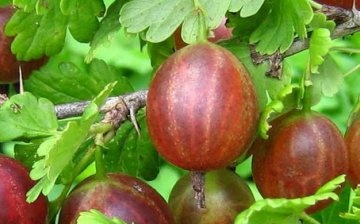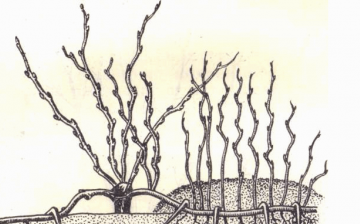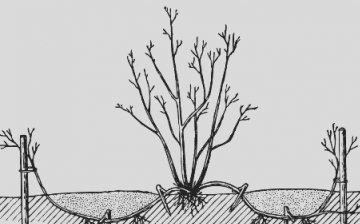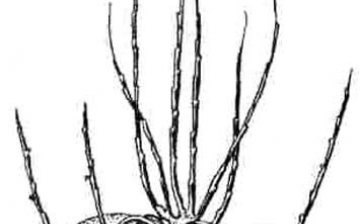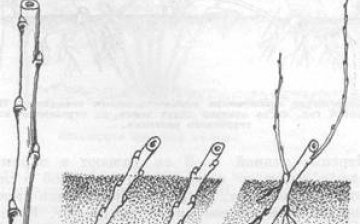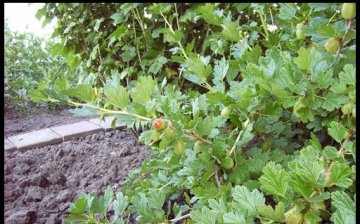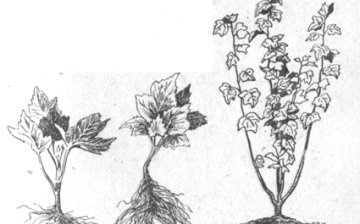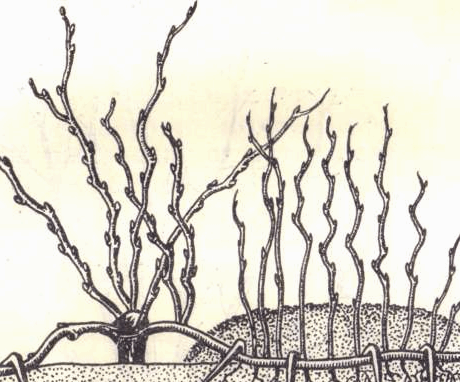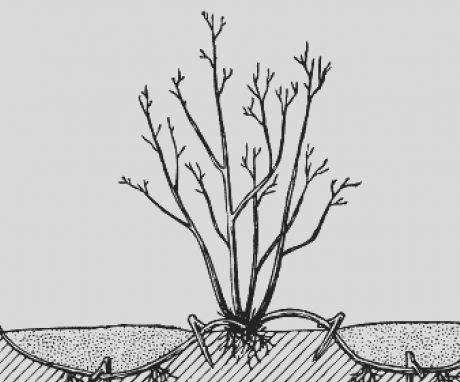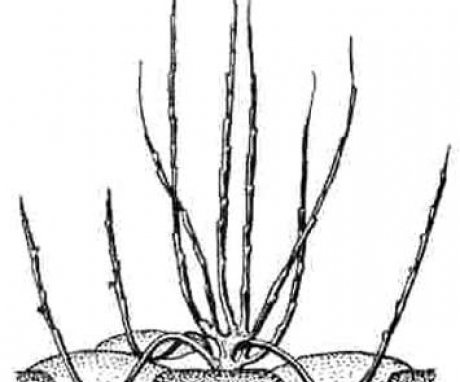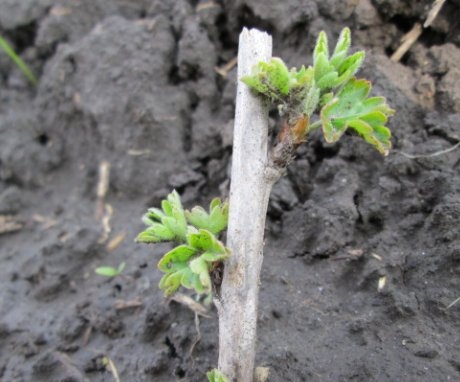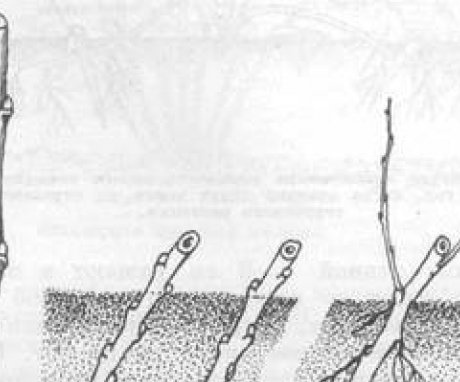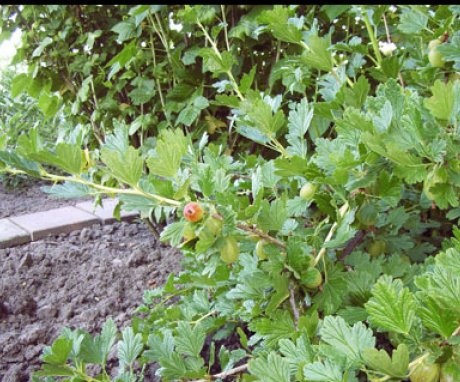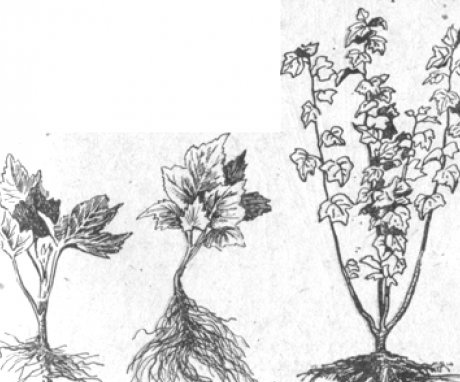Various breeding options for gooseberries
Gooseberry is a low-calorie and quite healthy fruit. This plant belongs to the category of perennial shrubs, the diameter of which can reach two meters, and the height is 1.5 meters. The gooseberry is very fond of moisture and light, therefore, it is necessary to plant it in slightly darkened and humid places. The distance between the bushes should be at least one meter, as they will grow over time and create a solid wall. There are thorns on the branches of this plant, which provides discomfort during harvest. The gooseberry bears fruit in small green berries.
Content:
- Applying horizontal layering
- Using arcuate layering
- Using vertical layering
- Using green cuttings
- Using lignified cuttings
- Features of dividing the bush
- Using combined cuttings
Applying horizontal layering
Multiply gooseberry can be done in several ways... Gooseberries can be propagated both by seeds and vegetatively. The choice of breeding method for this plant directly depends on its variety. Let's consider the most common methods of propagation of this plant.
This method of propagation of gooseberries requires the use of fertile, healthy and pure-bred plants.
To produce this reproduction, you must:
- Select multiple branches that are one year old to three years old.
- From these branches, it is necessary to cut off young growths by a third of their length.
- Next, the tops of the branches are trimmed.
- After that, the gardener needs to dig special grooves in the ground under the bush, where the cut gooseberry pagons will fit.
- It is imperative to pin the pagons.
- For this, special wooden or metal studs are used.
- The grooves must be covered with earth and watered.
- After a certain period of time, vertical shoots will appear from the grooves.
- After the height of the shoots becomes 8-10 centimeters, they must be earthed. It is necessary to repeat the hilling procedure in two weeks.
Throughout the summer, you need to monitor the condition of the soil. It should be loose around the shoot. Also regularly remove weeds around the shoots. New shoots must be constantly fed with moisture. This requires constant mulching of the soil after watering them.
Peat or humus can be used as mulching.
Layers should be in the ground all summer, and at the end of the first autumn month, the central branch is cut off at the base. The pagons are dug out, and the central branch between them is cut. You can save seedlings in cellars or plant them in the ground. The second method will be less reliable, as the layers can freeze in winter. In order to layering strengthened they need to be grown one more summer.
The best quality seedlings can be obtained by laying cuttings in October, although this procedure can also be carried out in the spring.
Spring layering is done before the buds have blossomed on the branches. Despite the laboriousness, this method is one of the most effective in plant propagation.
Using arcuate layering
When using arcuate layering, you must:
- Choose strong shoots that are one year old.
- They need to be shortened and bent in an arc.
- It is premature to dig holes in which the shoots will fit.
- After performing this procedure, it is necessary to pin the tops using metal or wooden studs.
- To fill up the holes, it is necessary to choose humus soil. This will encourage the gooseberries to sprout quickly.
- Small mounds are made over the holes. If they are violated, it is necessary to perform the renewal procedure.
In no case should the land be allowed to dry out in the summer, otherwise shoots may not appear.
Therefore the hillocks need to be watered regularly and mulch with peat. In the fall, it is necessary to separate the layers from the main bush and dig them out. If the layers have grown stronger and have a good root system, then they can be planted in the place of the future bush. This technique is quite simple and effective. At the same time, the multiplication factor by this method is not high enough.
One branch is capable of producing only one rooted plant.
Using vertical layering
This method is quite effective only if the plant has been growing in the ground for two years.
Initially you need:
- Cut off the aerial part of the main plants, leaving hemp, which are characterized by the presence of well-developed buds. The size of the stumps should be between five and ten centimeters.
- The soil around them needs to be loosened very well and carefully. In order to increase the number of sprouts, it is necessary to provide the plant with good care and frequent watering.
- After the height of the shoots becomes 10-12 centimeters, it is necessary to make the first hilling of the stumps. In this case, the center of the bush is densely covered with earth. This will prevent the branches from drawing closer together.
- In dry weather, this plant needs to be watered very often.
- The second hilling of the bush is carried out 2-3 weeks after the first.
Layers must be separated from central bush in autumn... Also, this procedure can be performed the next year in early spring. Shoots need to be grown throughout the next year, and after that they can be planted in a permanent place. In this case, the shoots must be cut very shortly.
Using green cuttings
This plant can be propagated by green cuttings. The procedure must be performed in June. This technique provides a high yield of seedlings.
For cutting gooseberries, it is best to use young growths that have formed in the current year.
The grafting procedure should be done in the morning or after lunch. This is due to the fact that during this period the plant contains the most dry matter. Initially, you need to select the harvested shoots and cut them using a sharp knife on the cuttings... The length of the cuttings should be about 10-12 centimeters.
It is best to plant cuttings in the early morning at a slight angle.
In order for them to take root better, green cuttings are best treated with a growth regulator before planting. After the plant takes root, it needs to provide comprehensive care, which consists in watering, loosening the earth, feeding.
Using lignified cuttings
It is best to propagate in this way gooseberry varieties, which take root very easily. For propagation of gooseberries, it is best to choose gooseberry cuttings that were harvested in the fall. This is due to the fact that they have a very large supply of plastic substances.
The length of the cuttings should be between 20 and 122 centimeters.
Prepared cuttings are necessary:
- Place in wet sand. They stay in this soil for one and a half to two months.
- The storage temperature should be around 2-3 degrees Celsius.
- It is necessary to store the cuttings in a snow pile until spring, having previously covered it with sawdust.
Cuttings are planted in early spring. The distance between them should be about 5-10 centimeters. In the spring-summer period, it is necessary to provide full care for the cuttings - water, loosen, and also fertilize... After a year, it is necessary to plant the cuttings in a permanent place.
Features of dividing the bush
If the gardener needs to transplant the bush to a new place, then at the same time it is possible to reproduce it.
Initially you need:
- Dig up old gooseberry bushes and remove all old branches from them... In this case, it is necessary to leave only young branches. Also, young roots should be present on the bush.
- After the bush is dug out, it is necessary to shake off the earth from it and divide it into several parts. At the same time, gardeners remove old roots. The roots that remain must be trimmed.
- Next, a hole is dug with a shovel.
- At the bottom of the pit, it is necessary to lay out fertilizers, which can act as humus.
- Next, the prepared part of the bush of this plant is placed in the hole, after which it is backfilled with earth.
- After performing this procedure, the bush must be watered.
It is possible to reproduce gooseberries using this method both in the spring and in the autumn. It is best to reproduce this way in the spring. This is due to the fact that in spring the weather accompanies the survival and blooming of the bush.
Using combined cuttings
The gooseberry propagation method is very effective, for which combined cuttings are used. They consist of a young shoot, which at the end has a part of an old pagon.
Thanks to this old pagon, called the heel, the stalk is protected from decay.
Gooseberries are propagated in this way in June. In this case, the heel is placed in the ground, and the young stalk is located on the ground. After planting the cutting, he needs to provide full care. Water the cutting every two weeks, and if the soil dries out very quickly, then the procedure must be increased.
Gooseberry shoots must constantly feed on moisture.
That is why, after watering them, the soil must be mulched. For this, peat or humus is used. The soil around the shoot must be constantly free of weeds. There are many ways to propagate gooseberries. At the same time, it is very difficult to identify the most effective one. This is due to the fact that one type of propagation is suitable for one variety of gooseberries, and the second for the second. That is why, before propagating gooseberries, you need to learn as much as possible about the features of its reproduction and choose the most optimal way... For this, it is best to consult with experienced gardeners. Otherwise, you can spend a lot of time and effort on ineffective ways.
More information can be found in the video.



